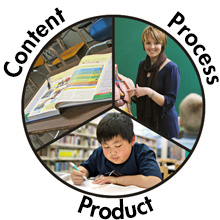How do teachers differentiate instruction?
Page 4: Differentiate Instructional Elements
 As teachers begin to differentiate instruction, there are three main instructional elements that they can adjust to meet the needs of their learners:
As teachers begin to differentiate instruction, there are three main instructional elements that they can adjust to meet the needs of their learners:
- Content—the knowledge and skills students need to master
- Process—the activities students use to master the content
- Product—the method students use to demonstrate learning
Differentiating instruction involves making changes to one or more of these elements. There is no prescribed way to differentiate instruction: The changes a teacher makes to each of the classroom elements depends on the needs of his or her students.
For Your Information
The learning environment is sometimes included as one of the classroom elements associated with differentiated instruction. It refers to the organization and atmosphere of the classroom. Without an effective learning environment with rules, procedures, and respect for others, differentiating content, process, and product might be more difficult to accomplish and may not result in the expected positive outcomes. Some ways in which the teacher can differentiate the learning environment include:
- Creating places in the room where students can work quietly without distraction while also providing areas where students can work together
- Offering multicultural materials
- Developing procedures for students to get help when they are working with other students
Making adjustments to these instructional elements often requires teachers to change their approach to instruction. Listen as Carol Ann Tomlinson discusses why this is often the biggest challenge teachers encounter when they begin to differentiate instruction (time: 1:14).

Carol Ann Tomlinson, EdD
Professor of Educational Leadership, Foundations, and Policy
The University of Virginia
Charlottesville, VA
Transcript: Carol Ann Tomlinson, EdD
I think the biggest challenge in differentiation is not differentiation itself but change. There really is nothing that is particularly complicated about what differentiation asks teachers to do. But most of us develop pretty deep ruts of teaching within our first two or three years, and those ruts and routines become the rhythm of the day. And differentiation does ask you to break out of those. So I think it really is not so much adopting a new thing but shedding the old thing that really is the challenge. For example, most teachers have learned to direct classrooms with sort of a frontal control mechanism with the belief that we have to be standing in front of the kids for them to learn anything, and that if we let them work collaboratively or independently they would self-destruct. We are much more comfortable giving one set of directions and asking everybody to do the same thing and start and stop at the same time. And those are pretty big patterns, and it’s a little hard to differentiate instruction and maintain those patterns. So it’s frequently learning to think in a new way, I think, that’s the greatest challenge.